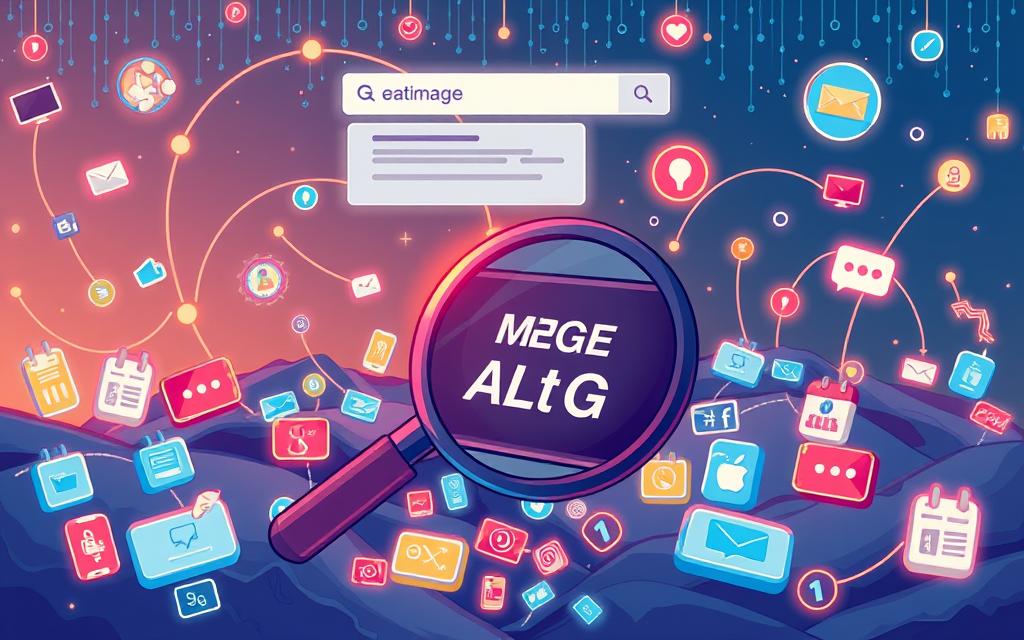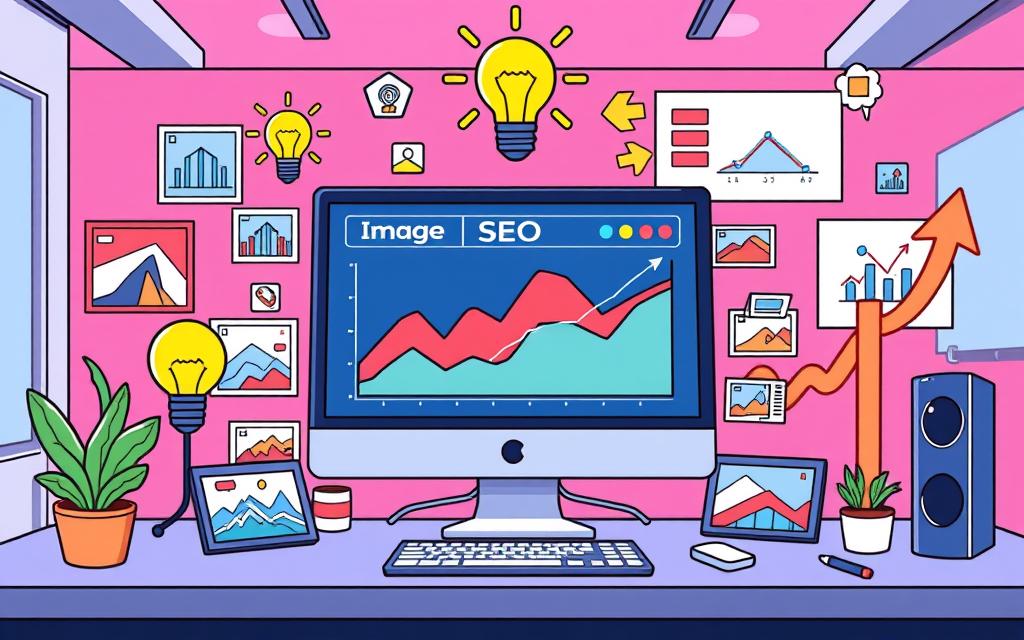Google Search offers many tools to help users find what they need visually. This includes text result images, Google Discover, and Google Images. By optimizing your images, you can get more traffic to your site. Why google image seo matters for personal reputation, image seo techniques to boost online reputation, and improving online reputation with google image search optimization are key. Also, using image seo to manage negative online reputation, how to optimize images to influence google search results, and the role of google images in online brand reputation are important for your online presence.
You can ask for a free consultation with Reputation Return here >>>
Image SEO involves several techniques. These include resizing and compressing images, using descriptive filenames and alt text, and implementing responsive image scaling. By following these best practices, you can make your images more visible in Google Search. This can help improve your online reputation and reach.
Key Takeaways
- Google Images is a powerful tool for driving traffic and enhancing your online reputation.
- Optimizing images through techniques like compression and responsive design can improve their visibility in Google Search.
- Descriptive filenames, titles, and alt text help search engines understand and index your images more effectively.
- Leveraging the latest image formats like WebP and AVIF can improve performance and user experience.
- Implementing strategies like lazy loading and disabling inline linking can further optimize your image SEO.
Help Search Engines Discover and Index Your Images
To make sure your images are found and indexed by search engines like Google, follow some key steps. First, use standard HTML image elements, like the tag, to add your images to your website. This helps search engine crawlers find and process your images.
Use HTML Image Elements to Embed Images
Using the tag correctly is a basic step. It makes your images discoverable. Search engines like Google can then find and index your images. This boosts your online reputation management and the influence of Google image search results on brand reputation.
Submit an Image Sitemap
Also, think about submitting an image sitemap to search engines. This gives them the URLs of your images. It helps crawlers find visual content they might miss, like images on a content delivery network (CDN). Submitting an image sitemap is a key step in leveraging image SEO for online reputation defense.
Optimize for Responsive Images
- Use the
element or thesrcsetattribute for responsive image scaling. This makes your images adjust to the user’s device size automatically. - This makes the user experience better and speeds up page loading. Both are key in google image algorithm changes and online reputation management.
By following these best practices, you can help search engines find, process, and index your images better. This improves their visibility in Google image search results and boosts your online reputation.

Choose Supported and Optimized Image Formats
Choosing the right image formats is key to boosting your company’s reputation on Google Image SEO. Google Search supports many formats like JPEG, PNG, WebP, BMP, GIF, and SVG. Each has its own strengths and weaknesses, affecting file size, quality, and features like transparency and animation.
Understand Different Image Formats
To get your images noticed by search engines, pick the best format for your needs. WebP is a good choice because it balances size and quality well. It’s also supported by most browsers. Using image compression can make files smaller without losing too much quality, which helps your site load faster and feel better to users.
See our service for Google image indexing, ranking and syndication >>>
Optimize for Speed and Quality
- PNGs keep image quality high even after compression, great for small, detailed images or illustrations.
- JPEGs can make files much smaller with some loss of quality, perfect for big images like hero shots or product photos.
- WebP supports both lossless and lossy compression, animations, and transparent backgrounds, offering a good mix of size and quality.
Even though WebP isn’t supported by older browsers like Edge 12-17, its popularity is growing. It’s a smart pick for modern websites and reputation crisis management using google image seo. Remember, making images smaller and resizing them is crucial for your site’s speed, which affects your image alt tags and their role in google reputation management.

“90% of people are more likely to purchase from businesses that have photos included in their organic or local results.”
By knowing about different image formats and optimizing them, you can improve company reputation with google image seo. This also makes your website better for users.
google image seo
In today’s digital world, first impressions are often made online. Google Image SEO is key for those wanting to improve their online image. It helps drive more traffic and shape how people see your brand or personal image.
Google Image SEO helps reduce the impact of negative search results. When people search for you, the images that show up matter a lot. By making sure your good images rank higher, you can hide any bad content and protect your reputation.
Also, Google Image SEO boosts your website’s performance. Since many searches involve images, optimizing them can increase site traffic and engagement. Posts with images get 650% more engagement than those without. This way, you can grab your audience’s attention and build a stronger online presence.
“Visual search is a significant aspect of SEO and provides increased traffic. Google Images feature filters, metadata, and attribution, making it essential to optimize your images for search engines.”
To get the most out of Google Image SEO, you need to know the best practices. This includes choosing the right image formats, optimizing file sizes, and using responsive design. A detailed approach is necessary for success.

Investing in a good Google Image SEO plan can greatly improve your online image. It can also bring more qualified visitors to your site. Whether you’re a public figure or a business, mastering Google Image SEO can be a big advantage in the digital world.
Create Unique and Original Images
Starting to build your online reputation begins with creating unique images. Stock photos might be easy, but they can make your site look generic. Instead, spend time making your own high-quality, relevant images. These images will add value to your content and help you stand out.
Unique images are more likely to show up in search results. This is because search engines can understand the context and relevance of your visuals better. By using your own original images, you can improve the user experience. This strengthens your brand identity and positively affects your online reputation, including using google image seo to enhance personal reputation and enhancing corporate reputation with google image seo.
- Unique images enhance the user experience and can increase dwell time on your website.
- Original visuals help convey your brand’s unique personality and values.
- Google’s image search algorithms favor unique images over stock photos, leading to better visibility in search results.
The secret to creating effective images for google image seo to enhance personal reputation and enhancing corporate reputation with google image seo is to make them visually appealing. They should be relevant to your content and offer real value to your audience. By investing in unique and original images, you can significantly improve your online presence and reputation.

“Unique images can make a significant difference in how your brand is perceived online. They showcase your attention to detail, creativity, and commitment to providing a high-quality user experience.”
Optimize Image Landing Pages
To make your images more visible in Google search results, optimizing the landing pages is key. This is how you fix your reputation with better google image seo practices and rank positive images for online reputation improvement.
Optimize Page Titles and Descriptions
Make sure your page titles and meta descriptions match what’s on your images. Use keywords that describe the image well. Write compelling copy to get people to click on your link. This makes your images more likely to show up in search results.
Add Structured Data for Rich Results
Use structured data markup like JSON-LD or Schema.org to give search engines more info about your images. This can lead to rich results, like badges or carousels, in Google Images. It helps search engines understand your images better, making them more visible and attracting more visitors.
| Optimization Tactic | Benefit |
|---|---|
| Descriptive Filenames | Ideally, file names should be descriptive and clear, aiding Google in understanding the content. |
| Keyword-Rich Alt Text | Alt text can enhance click-through rates by incorporating relevant keywords. |
| Optimized Page Speed | Monitoring and reducing page load times is crucial for user experience and SEO. |
| Image Sitemaps | Providing an image sitemap file can simplify the path for search engines and improve organization. |
Optimizing your image landing pages can greatly improve your visuals’ visibility in Google search results. This helps fix your reputation with better google image seo practices and rank positive images for online reputation improvement.

Use Descriptive Filenames, Titles, and Alt Text
Optimizing images for search engines is key to boosting your online reputation. Using descriptive filenames, titles, and alt text is essential. Search engines like Google use these to understand your images, affecting their ranking in search results.
Follow Guidelines for Descriptive Filenames
Give your images descriptive, keyword-rich filenames. Avoid names like “IMG001.jpg” and choose something that accurately describes the image. Keep it short, informative, and use hyphens to separate words. This makes it easier for search engines to index your images, improving their image SEO techniques to boost online reputation.
Write Effective Alt Text
Alt text is vital for image optimization. It describes the image when it can’t be shown and helps search engines and screen readers. Write it concisely yet clearly, focusing on how to optimize images to influence google search results. This boosts accessibility and helps search engines understand your visuals, enhancing your role of google images in online brand reputation.
By using descriptive filenames and effective alt text, you can make your images more discoverable and relevant. This boosts your online reputation and visibility.
Resize and Compress Images
Improving your online image starts with better visual content. One key google image seo tactic is to resize and compress images. This makes your website load faster, which search engines and users like.
First, make your images the right size for your site. Don’t use HTML or CSS to resize, as it slows things down. Use tools like Adobe Photoshop or TinyPNG and Squoosh to keep images looking good while saving space.
Compressing images is also crucial. You want them to look great but not take too long to load. This makes your site better for visitors and search engines, helping your online reputation.
| Image Format | Typical File Size | Pros | Cons |
|---|---|---|---|
| JPEG | 10-300 KB | Suitable for images with many colors, allows for high-quality compression | May lose quality with higher compression |
| PNG | 50-500 KB | Supports transparency, suitable for simpler images | Larger file size compared to JPEG |
| GIF | 10-100 KB | Supports animation, suitable for simple graphics | Limited color palette, not suitable for photos |
By resizing and compressing images, you make your website fast and attractive. This improves user experience and search rankings. It also helps protect your online reputation and image.
Implement Responsive Image Scaling
Making sure your website’s images fit the user’s device size is key for how image seo can reduce negative search results. It also makes browsing better. Responsive image scaling stops images from being too big or too small on different devices. This keeps your site looking good on all screens, which search engines like.
This makes your site more user-friendly and boosts your google image visibility and its effect on online perception.
To make your images scale right, follow these tips:
- Use CSS media queries to adjust image sizes based on screen size.
- Leverage the
srcsetandsizesattributes in your HTML to provide the browser with multiple image options and let it choose the most appropriate one. - Optimize images for different device resolutions by providing high-quality, mobile-friendly versions.
- Utilize tools like responsive image breakpoints generators to determine the best image sizes for your website.
Responsive image scaling makes your website’s images fit all devices perfectly. This gives users a great experience and helps your site’s reputation and visibility online.
“Responsive image scaling is a critical component of modern web design, ensuring your visuals are optimized for every user, regardless of their device.” – [https://reputationreturn.com/how-to-use-seo-as-part-of-a-reputation-crisis/]
Enable Lazy Loading
Improving your online presence often means making your website faster. One key way to do this is through lazy loading. This technique loads content, like images, only when you need it.
Lazy loading makes your site load quicker by only loading images when you see them. This is great for improving online reputation with google image search optimization. Faster sites give users a better experience and can rank higher in search results.
Getting lazy loading right is important. You can use browser features, the IntersectionObserver API, or JavaScript libraries. Each method has its own way of loading content when it’s needed.
Don’t use lazy loading for content you see right away. It could slow down your site. Also, make sure infinite scroll uses unique URLs for each part of content. This helps search engines index your site properly.
Use Google Search Console’s URL Inspection Tool to check if your lazy-loaded content is working right. Keep an eye on how your lazy loading is doing. This helps keep your site fast and visible to search engines.
By using lazy loading wisely, you can make your site faster and more user-friendly. This helps a lot with google image seo tactics for enhancing online reputation and improving online reputation with google image search optimization.
| Lazy Loading Techniques | Advantages | Considerations |
|---|---|---|
| Browser Built-in Lazy-loading | Simple implementation, no additional libraries required | Limited browser support, may not work for all scenarios |
| IntersectionObserver API | Efficient viewport-based monitoring, progressive enhancement | Requires polyfill for older browsers, additional setup complexity |
| JavaScript Libraries | Comprehensive solutions, advanced features and customization | Potential increase in initial page load, dependencies to manage |
Opt Out of Google Images Inline Linking
Take control of your online reputation by managing how your images show up in Google. The Google Images inline linking feature shows full images in search results, skipping your website. By opting out, you ensure users visit your web pages, offering more context and engagement chances.
Preventing inline linking helps in using image SEO to manage negative online reputation and boost your brand’s reputation on Google. When users click on your images, they land on your website. There, you can share relevant info, calls-to-action, and more, supporting your online presence.
Two Ways to Opt Out of Google Images Inline Linking
- Add a robots.txt rule: Include a
Disallow: /images/directive in your website’s robots.txt file. This stops Google from showing your images inline, giving you control over search results. - Implement the noindex X-Robots-Tag: Add the
noindexX-Robots-Tag HTTP header to your image landing pages. This tells Google not to index the full images, directing users to your website instead.
| Method | Advantages | Considerations |
|---|---|---|
| Robots.txt |
|
|
| noindex X-Robots-Tag |
|
|
By using these methods, you can actively manage your online reputation. This ensures your images lead traffic and engagement to your website, not just appearing on the search engine results page.
“Controlling how your images appear in Google search can be a powerful tool for managing your online reputation and brand visibility.”
Leverage Latest Image Formats Like AVIF
In the world of digital marketing and SEO, keeping up is key for public figures protecting their online reputation and businesses wanting to reduce negative search results. The AVIF image format is a big deal for SEO experts.
AVIF, or the AV1 Image File Format, is a new way to compress images. It makes files up to 50% smaller than JPEGs and WebPs without losing quality. This means your website can load faster, which is good for users and search engines.
| Image Format | File Size Range (4K Image) | Advantages | Disadvantages |
|---|---|---|---|
| JPEG | 1 MB – 5 MB | Widely supported, good for photographs | Lossy compression, limited quality |
| PNG | 15 MB – 25 MB | Supports transparency, suitable for graphics | Larger file sizes, not ideal for photographs |
| GIF | 5 MB – 10 MB | Supports animations, limited color palette | Larger file sizes, limited use cases |
| WebP | 0.5 MB – 10 MB | Balanced quality and file size, good for mixed content | Less compression than AVIF, some browser compatibility issues |
| AVIF | 0.5 MB – 3 MB | Superior compression, high-quality images, smaller file sizes | Newer format, not yet universally supported |
Even though AVIF support is growing, you should also use WebP or JPEG for older browsers. This way, everyone can see your images well.
Using the latest image formats like AVIF is smart. It helps protect your online reputation and reduces negative search results. Optimizing your images can make your website faster, better for users, and more visible in search engines.
“AVIF images can help significantly improve page speed, leading to faster downloads and enhanced user experience.”
Conclusion
Optimizing your images for Google Search can greatly improve your online presence. By using the right image formats and descriptive filenames, you help search engines find and display your images. This makes your visuals more visible in search results.
In 2020, over 25% of Google Organic Traffic came from image searches. Google image search is the second most popular search platform after Google.com. This shows how important google image seo tactics for enhancing online reputation are. Your images can greatly influence how to optimize images to influence google search results and your brand’s reputation.
Alt texts are key for image SEO, according to Google. Proper naming and alt text help search engines understand your images. This can boost your SEO and visibility in image-based search results, including featured snippets.
Using the latest image formats like WebP can also improve your website’s performance. WebP offers superior compression without losing quality. This can enhance your online reputation by making your website faster and more user-friendly.
“Optimizing your images for Google Search can have a significant impact on your online visibility, traffic, and reputation.”
Remember, google image seo tactics for enhancing online reputation, how to optimize images to influence google search results, and the role of google images in online brand reputation are all connected. By mastering these strategies, you can use visuals to improve your online presence and manage your brand’s reputation in the digital world.
How Reputation Return Can Help
Reputation Return offers top-notch Google image SEO, picture syndication, and image ranking services. We help individuals and businesses boost their online reputation. Our experts analyze your image optimization, find ways to improve, and use smart image SEO tactics.
We focus on making your images more discoverable and attractive. This can draw more positive attention and help manage negative search results. It’s great for public figures, businesses, and professionals looking to improve their reputation online.
If you want to be more visible online, counter negative content, or lead in your field, we’re here to help. The Reputation Return team uses Google image optimization to help you reach your goals. Contact us today to see how our services can help your reputation.

